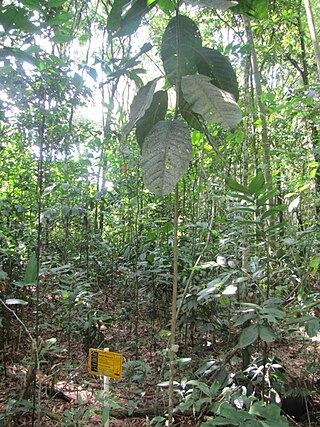
The Magnoliaceae are a flowering plant family, the magnolia family, in the order Magnoliales. It consists of two genera: Magnolia and Liriodendron.

Magnolia is a large genus of about 210 to 340 flowering plant species in the subfamily Magnolioideae of the family Magnoliaceae. The natural range of Magnolia species is disjunct, with a main center in east and southeast Asia and a secondary center in eastern North America, Central America, the West Indies, and some species in South America.

Magnolia tripetala, commonly called umbrella magnolia or simply umbrella-tree, is a deciduous tree native to the eastern United States in the Appalachian Mountains, the Ozarks, and the Ouachita Mountains. The name "umbrella tree" derives from the fact that the large leaves are clustered at the tips of the branches forming an umbrella-shaped structure.

Liriodendron chinense is Asia's native species in the genus Liriodendron. This native of central and southern China grows in the provinces of Anhui, Guangxi, Jiangsu, Fujian, Guizhou, Hubei, Hunan, Jiangxi, Shaanxi, Zhejiang, Sichuan and Yunnan, and also locally in northern Vietnam. Protected populations occur in the Tianmushan National Reserve, Huangshan, Wuyi Shan, and Badagongshan Nature Reserve.

Magnolia hodgsonii, known in Chinese as gai lie mu is a species of Magnolia native to the forests of the Himalaya and southeastern Asia, occurring in Bhutan, southwestern China, Tibet, northeastern India, northern Myanmar, Nepal, and Thailand. It grows at moderate altitudes of 850–1500 m with a subtropical climate.
Magnolia boliviana is a tree in the family Magnoliaceae native to the rainforests of the eastern Andean foothills of Bolivia.

Magnolia dealbata is a species of flowering plant in the family Magnoliaceae, native to Mexico. It is known commonly as the cloudforest magnolia and eloxochitl. It is sometimes considered to be a subspecies of Magnolia macrophylla, which is otherwise native to the southeastern United States.

Magnolia hernandezii is a species of plant in the family Magnoliaceae. It is endemic to Colombia. The tree can attain a height of up to 40 m and trunk diameter approaching 1 m with smooth, light-brown or light-grey bark. It has a woody, globular fruit with up to 15 cm diameter.
Magnolia ovoidea is a species of flowering plant in the family Magnoliaceae. It is endemic to China. There are only four small subpopulations of this critically endangered species.
Magnolia coriacea is a species of flowering plant in the family Magnoliaceae. It is native to China. There are no more than about 500 individuals remaining of this endangered species.
Magnolia dixonii is a species of flowering plant in the family Magnoliaceae. It is endemic to Ecuador. It is known commonly as cucharillo.
Magnolia poasana is a sub-tropical to tropical, subcanopy tree, growing in areas of montane rainforest. The names "Poas", and "poasana" originate from the Poás Volcano in Costa Rica where, along with Panama, they grow in the wild. First described by Henri François Pittier in 1910, it was later described and included in Magnolia by James Edgar Dandy (1927).

Magnolia liliifera, commonly known as egg magnolia, is a flowering tree native to the Indomalayan realm. It bears white to cream-colored flowers on terminal stems. The leaves are elliptical and get as large as 25 cm (10 in) long and 8 cm (3 in) wide. The tree ranges in height from 3.5 to 18.5 m in situ.

Magnolia jardinensis is a tree native to Colombia and endangered due to its exploitation. Common names include Gallinazo blanco, copachí and centello.

Magnolia nilagirica is a species of plant in the family Magnoliaceae. It is a tree that is threatened by habitat loss, endemic to the Western Ghats of India, and also Sri Lanka.

Magnolia sinica is a species of flowering plant in the family Magnoliaceae, native to southeast Yunnan Province, China. It is categorized as Critically Endangered. There are an estimated 50 wild individuals remaining. As it is a tree reaching 40 m (130 ft) with a straight trunk, it is subject to logging pressure.
Magnolia pedrazae is a species of flowering plant in the family Magnoliaceae. It is endemic to the Sierra Madre Oriental of eastern Mexico.
Magnolia vazquezii is a species of flowering plant in the family Magnoliaceae. It is endemic to the Sierra Madre del Sur of Guerrero state in southern Mexico.
Magnolia macclurei is a species of flowering plant in the family Magnoliaceae, native to southern China, including Hainan, and northern Vietnam. A tree reaching 30 m (98 ft), it is found growing in evergreen broadleaf forests, from 200 to 1,500 m above sea level.

Magnolia maudiae, the smiling monkey forest tree, is a species of flowering plant in the family Magnoliaceae. It is native to southern China, including Hainan. A shrubby tree occasionally reaching 20 m (66 ft) in the wild, it is found growing in evergreen broadleaf forests from 600 to 1,500 m above sea level. A well-shaped evergreen species, it blooms early with heavily fragrant white flowers, and has attractive bluish-green leaves. It is used as a street tree in southern Chinese cities.












